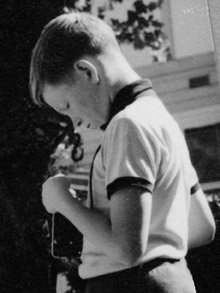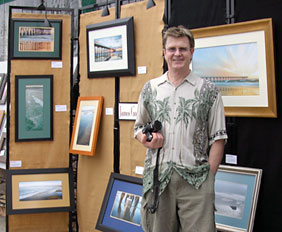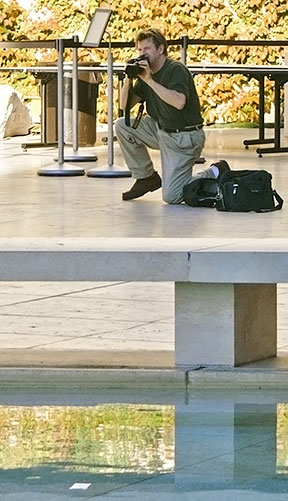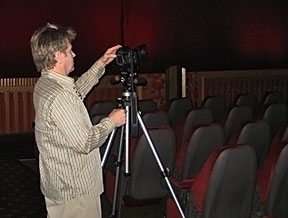
by Jim Everett
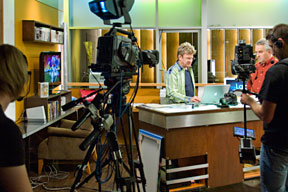
2009 saw my video podcast "Digital Photography and Artistry" included in a worldwide email promotion by Apple for iTunes, as one of six under "Learn from the Pros". This free podcast now has around 6,000 regular subscribers.
Along with other recent acknowledgements and exhibitions, this suggests to me I am moving in the right direction on my journey. A couple of years back, I was invited as a guest for three 10-minute TV spots on G4 Tech TV (How To in Australia), on the show, "The Lab With Leo Laporte".
In this bio story, I want to share both my inspirations, support from people along the way, and some traumatic childhood events, as well as happier times. These are pivotal points in my journey, that eventually led to the joy I get from my artistry, and am able to share with others many years later.
---
Originally from Australia, I have lived in California since 1993, and find North America to be an unbelievably wondrous place for visual splendor and photography. I have also had the opportunity to photograph around the world.
Why the name, James Gordon Gallery? James and Gordon are my two given names, and my family (father's) name is Everett.
My grandfather, a poet, was James Gordon, and my uncle, who was killed in World War 2, was "Jimmie" Gordon. Growing up, I was referred to as "Little Jimmie", or "young James Gordon". My grandfather roamed the country on foot with Henry Lawson, who gave my grandfather the writer name of Jim Grahame. Lawson was Australia's equivalent of Mark Twain, and had his portrait on one issue of the Australian $10 note. The James Gordon site is a tribute to my grandfather, the poet.
My desire to in capture images began at an early age, as you see here at right. My dad made me a cheap toy camera that did not even take pictures, but I loved it. A far cry from today, when some parents buy sophisticated digital cameras worth hundreds of dollars for their four-year children.
From that time, all those years ago in Leeton NSW, I have had a long and interesting journey. And these days, my recent recognition in Los Angeles as a photographic artist and a voice on digital images makes the journey worthwhile. I now know what my work in meant to say.
The early formative years
This picture (above right) was about a year after my mother died. She passed away in great pain on the morning of my third birthday. I don't think that my family had broken the news to me yet when this picture was taken. They told me that she had gone on holidays.
As a dying wish of my mother, I went to live with my grandmother and aunt. Later in my life, my grandmother told me that when we went out, I was forever looking at people, wondering if I would see my mother. So maybe that early experience of constantly scanning people's faces atttuned me to watching and studying people in public.
When I was six years old, my grandmother ("Nana"), took me to visit Mary, a friend of hers who lived in the area of Sydney that was the hub of artists and writers in the mid-20th century, Kings Cross. That friend was Dame Mary Gilmore, a champion for justice and the underprivileged. She (as did Henry Lawson mentioned above) also later had her portrait on the Australian $10 note.
In a letter to my grandmother, Mary mentioned me as "young James Gordon Everett - one day his voice will be heard". That set up for me quite an expectation and challenge. I am still working on that one!
___
But ironically, my real start in photography came from a serious injury shortly after my 10th birthday, and quite small. I was purposefully knocked off my heavy old bike by a large classmate and close neighbour, who then crashed down on top of me, into a ditch beside the road.
My femur was completely snapped and the end of the bone almost pushed out through the skin. I was then left in the ditch, while he went to get my folks for help. It felt like hours (probably only 15 minutes) I lay there, alone and in pain, looking through a child's fearful eyes at my contorted leg.
I was rushed to hospital, was in traction in for months, then convalesced at home for a couple more months. While in hospital, my loving aunt gave me my first camera to cheer me up and provide me an interest. It was a basic Kodak Duaflex - no controls, but I loved it. That's me using it, at right in the 3rd picture from the top. And my love of photography began to be realized.
The bike incident changed my life. I was taken out of sports for a few years, and lost momentum in my studies for a year or so until I got into high school. The time away from school made me more self-sufficient and reflective, and I turned to my camera. I photographed everything - my family, my dog, my friends, the local river, my country town.
As an adult, I rediscovered my athletic side with running, skiing, squash, kayakking, golf, hiking, gym, and a range of other strenuous activities. I also became much more social, and to this day I love getting to know people and hearing stories from their lives.
Growing in the medium of photography
During my teenage years, my Uncle Ken a keen amateur photographer from Sydney took an interest in my technical learning, and taught me the basics of exposure, focus, lighting, and framing, as well as black and white darkroom techniques. My loving aunt Bon had, by default, become my mother. Even on her modest income as a nurse, she must have supported my photographic costs in those years.
That learning from my uncle would serve me well in later years, having a real sense of what Curves and Levels did in photo editing software. Yet at the time, I do not recall any encouraging words about my pictures from Uncle Ken, only a few disparaging comments. So part of my ongoing drive was to create pictures that would equal or better his.
But, I yearned for a "real" camera with controls, and bought a Kodak Retinette with the money from my first holiday job after I left school, and my photography took off from there, with a little further help from Uncle Ken. I set up our laundry with blackout, and the smell of hypo became very familiar.
While studying for my degree, wedding and school photography earned money for better cameras. but at that time, my heart was not really in work for hire at events. My real passion was for landscapes and nature, exotic places, unusual things and textures, people in public places, and cities. Married by now with a daughter, the small bathroom became my darkroom, and I honed my artistic skills and darkroom black and white photographic techniques.
Even so, from that time in commercial photography, I learned a lot about photographic techniques, quickly setting up shots to capture a fleeting moment, and working with people to help them be comfortable as subjects.
Later explorations
As luck would have it, my work and love of travel has taken me around the world to over twenty countries, and hundreds of thousands of pictures. I still get joy from some of the pictures that I took over thirty years ago. Some no longer meet my own standards of today, others stand the test of time.
One experience that set a challenge in my mind for years to come, was when I was traveling with a colleague who was a friend. I think at some level, he saw merit in my work, but had little patience for the time needed. We took a day out of the work schedule to drive through some stunning scenic areas. As the sun was rising one morning, it lit the dew from behind on pastoral grasses, creating a myriad of sparkling diamonds.
I was moved by the delicate beauty of the scene, and commented to my friend how much joy I got from lighting like this. He responded with, "You make it sound like you have some unique ability to see such things. Everyone sees the world the same!"
I knew his seemingly judgmental comment was not accurate. After all, throughout the centuries, artists have sought to learn how to see and portray light. So I worked even harder to see, feel and understand lighting, and use that in my images as part of what I sought to portray.
___
About fifteen years back, one event made a major impact on my pictures and allowed me to further understand and appreciate light. In 1995, my lovely Texan wife Jane gave me the gift of a photography workshop at Mono Lake, California, with Clinton Smith, who had studied under Ansel Adams.
What I learned from Clinton made a quantum leap in my work, and gave me the insight I needed for a magical tour of the New England area of the USA, when the autumn colors were at their peak. (This is also when I also proposed to my wife - and she said "Yes").
Recent expression and explorations
These days, I do all my "darkroom" color printing work with my trusty MacBook Pro and Cinema Display, and programs like Aperture, Lightroom and Photoshop, and an Epson Photo Printer. Apple's Mac OS X is so "human" and beautifully designed, I can do all my work in a creative mode.
And today, my printed pictures allow me to share my pleasure with many people. My work has been in notable exhibitions, I sell my work, I have had several TV appearances, featured in inflight programming, and been invited on several radio interviews. I have a popular video podcast on iTunes, "Digital Photography and Artistry", which Apple included in May 2009 in a worldwide promo.
And in Los Angeles, just a few years back, I was invited to include my images in an art auction to Save Ballona. Ballona Wetlands is a critical, unique and tenuous wetland on LA's west side. It has been a crucial part of the whole health of the Santa Monica Bay, and a refuge for migratory birds. I was able to view the fleeting yet magnificent annual display of wildflowers and birdlife, and see how the scene could be captured and highlighted as beautiful imagery. An aggressive and well connected local developer saw this area only as a swamp to be drained and as a site for densely packed condos and offices.
My wife Jane, an Interior Designer, is my most avid fan and patient supporter. Her support is closely followed by my long time Aussie friend, a journalist of note and now a documentary-maker and tour operator, Walter Pearson, who is always telling me how much he enjoys and thinks highly of my work. A close "photo buddy", Ellen has helped me along the way, discussing techniques, and getting me Apple-equipped. My daughter Di Kennedy, a graphic designer in Sydney, is also a big fan of my landscape work. My wife has also worked closely with me in creating the perfect designer frames for my prints.
I have other friends - Durnford, Stefan, and Bill, with whom I have enjoyed photo trips into interesting nature areas. Durnford King has got me thinking about industrial subjects with his work, and the late Fred Haines, a writer and director, awakened an interest in spontaneous portraits of people I meet. Jessica at Apple helped by get me into the Apple Aperture loop with a place on the three-day pro course. Bill has been of great help getting me engaged in Final Cut Pro for my podcast. Stefan was an enormous source of support for my TV spots on G4 Tech TV's "The Lab with Leo Laporte" in Vancouver.
Sean Carruthers and Matt Harris, who worked with G4 Tech TV, were instrumental in getting the TV spots, through seeing my podcasts.
___
Bruria Finkel a noted Santa Monica artist, curated the exhibition, "Distinctive Artists of Southern California" for the LA Department of Cultural Affairs, and invited me to include five printed pieces. I jumped at the chance.
And I have had the chance to work with Photo Marketing Association and to create media and articles for them. They were very supportive when I spent time pitching a TV series on photography, Gary Pageau and Chad Munce of PMAI in particular. My videos on photographic artistry are part of the online promotional service they offer to photo retailers around the world. And working with the Professional Picture Framers Association gave me a chance to create articles around framing and displaying photographic art.
My exploration into the world of television, where my series concept (American Snapshots) was reviewed at top levels of Travel Channel, and Discovery, allowed me to work with some very supportive people in the production side of the industry - people who loved my work, and were (and still are) excited by my ideas. John Kennedy and Anna-Gaelle Marshall of iO Productions, Roger Goff, an entertainment attorney, and Mark Heller, a promoter who opened many doors for me.
___
These days, the aim of my work is to capture a moment - the experience of being in a special place at a special time, and to view subjects from different perspectives and juxtapositions. I have been told that my work has a vulnerability to it. And that was meant in a positive way, as being a distinctive and appealing quality.
Perhaps those challenging events in my earlier life, along with the positive experiences, helped create this more thoughtful and perceptive approach, and I have now been able to blend them all into something very positive. I like to think so.
And I appreciate the wonderful support and glowing comments about my images from those many other friends and family not mentioned here. Their encouragement sustains me, and helps me value my own work.
One good place good place to start viewing my work is my "Favorites" page. But this is from a few years back, and my most recent work is on my flickr page.
And you can read about my photo thoughts and explorations at my blog, and use this as a place to explore lots more links to my work: "I Took That!"
Take the time to tour the gallery and the other places, e-mail your thoughts to me, or ask me about your own photographic work.
E-mail: jimg@jamesgordongallery.com
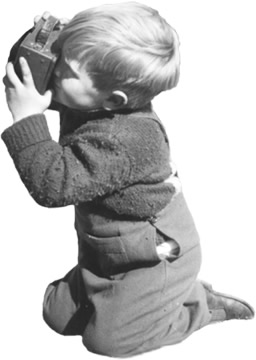 |
|
